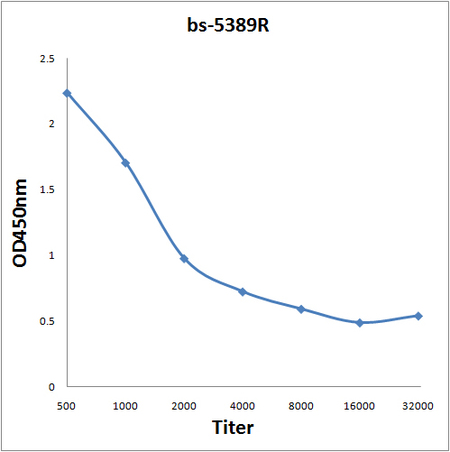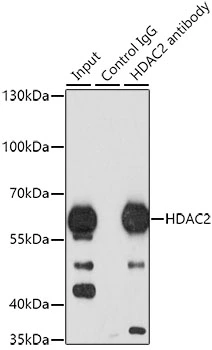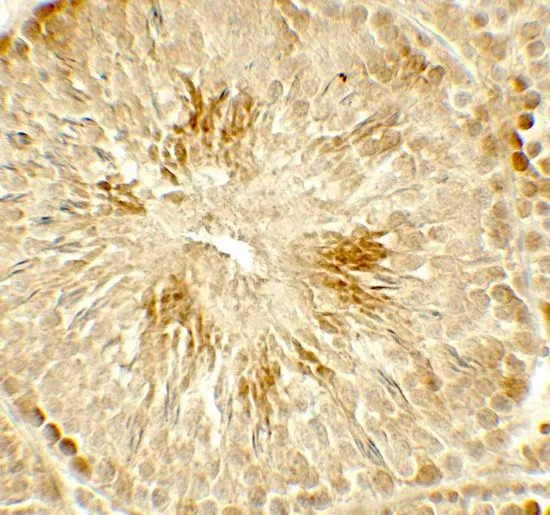HDAC2 antibody
GTX109642
ApplicationsImmunoFluorescence, ImmunoPrecipitation, Western Blot, ChIP Chromatin ImmunoPrecipitation, ImmunoCytoChemistry, ImmunoHistoChemistry, ImmunoHistoChemistry Paraffin
Product group Antibodies
ReactivityHuman, Mouse, Rat, Xenopus
TargetHDAC2
Overview
- SupplierGeneTex
- Product NameHDAC2 antibody
- Delivery Days Customer9
- Application Supplier NoteWB: 1:500-1:3000. ICC/IF: 1:100-1:1000. IHC-P: 1:100-1:1000. IP: 1:100-1:500. *Optimal dilutions/concentrations should be determined by the researcher.Not tested in other applications.
- ApplicationsImmunoFluorescence, ImmunoPrecipitation, Western Blot, ChIP Chromatin ImmunoPrecipitation, ImmunoCytoChemistry, ImmunoHistoChemistry, ImmunoHistoChemistry Paraffin
- CertificationResearch Use Only
- ClonalityPolyclonal
- Concentration0.83 mg/ml
- ConjugateUnconjugated
- Gene ID3066
- Target nameHDAC2
- Target descriptionhistone deacetylase 2
- Target synonymsHD2, KDAC2, RPD3, YAF1, histone deacetylase 2, YY1-associated factor 1, protein deacylase HDAC2, transcriptional regulator homolog RPD3
- HostRabbit
- IsotypeIgG
- Protein IDQ92769
- Protein NameHistone deacetylase 2
- Scientific DescriptionThis gene product belongs to the histone deacetylase family. Histone deacetylases act via the formation of large multiprotein complexes and are responsible for the deacetylation of lysine residues on the N-terminal region of the core histones (H2A, H2B, H3 and H4). This protein also forms transcriptional repressor complexes by associating with many different proteins, including YY1, a mammalian zinc-finger transcription factor. Thus it plays an important role in transcriptional regulation, cell cycle progression and developmental events. [provided by RefSeq]
- ReactivityHuman, Mouse, Rat, Xenopus
- Storage Instruction-20°C or -80°C,2°C to 8°C
- UNSPSC12352203
References
- Tapryal N, Chakraborty A, Saha K, et al. The DNA glycosylase NEIL2 is protective during SARS-CoV-2 infection. Nat Commun. 2023,14(1):8169. doi: 10.1038/s41467-023-43938-0Read this paper
- Chakraborty A, Sreenivasmurthy SG, Miller W, et al. Fructose-2,6-bisphosphate restores DNA repair activity of PNKP and ameliorates neurodegenerative symptoms in Huntington's disease. bioRxiv. 2024,:pii: 2023.10.26.564220. doi: 10.1101/2023.10.26.564220.Read this paper
- Zhou JJ, Cho JS, Han H, et al. Histone deacetylase 1 maintains lineage integrity through histone acetylome refinement during early embryogenesis. Elife. 2023,12. doi: 10.7554/eLife.79380Read this paper
- Yang HH, Chiang IT, Liu JW, et al. Anti-Excitotoxic Effects of N-Butylidenephthalide Revealed by Chemically Insulted Purkinje Progenitor Cells Derived from SCA3 iPSCs. Int J Mol Sci. 2022,23(3). doi: 10.3390/ijms23031391Read this paper
- Duan Y, Cao L, Yuan C, et al. Novel Function of Avian p53 in Binding to ALV-J LTR Contributes to Its Antiviral Roles. mBio. 2022,13(1):e0328721. doi: 10.1128/mbio.03287-21Read this paper
- Lin HY, Wu HJ, Chen SY, et al. Epigenetic therapy combination of UNC0638 and CI-994 suppresses breast cancer via epigenetic remodeling of BIRC5 and GADD45A. Biomed Pharmacother. 2022,145:112431. doi: 10.1016/j.biopha.2021.112431Read this paper
- Tapryal N, Shahabi S, Chakraborty A, et al. Intrapulmonary administration of purified NEIL2 abrogates NF-κB-mediated inflammation. J Biol Chem. 2021,296:100723. doi: 10.1016/j.jbc.2021.100723Read this paper
- Sayed IM, Chakraborty A, Abd El-Hafeez AA, et al. The DNA Glycosylase NEIL2 Suppresses Fusobacterium-Infection-Induced Inflammation and DNA Damage in Colonic Epithelial Cells. Cells. 2020,9(9). doi: 10.3390/cells9091980Read this paper
- Chen CY, Chen CC, Chuang WY, et al. Hydroxygenkwanin Inhibits Class I HDAC Expression and Synergistically Enhances the Antitumor Activity of Sorafenib in Liver Cancer Cells. Front Oncol. 2020,10:216. doi: 10.3389/fonc.2020.00216Read this paper
- Thang SK, Chen PY, Gao WY, et al. Xanthohumol Suppresses NPC1L1 Gene Expression through Downregulation of HNF-4α and Inhibits Cholesterol Uptake in Caco-2 Cells. J Agric Food Chem. 2019,67(40):11119-11128. doi: 10.1021/acs.jafc.9b05221Read this paper





![ICC/IF analysis of C6 cells using GTX01527 HDAC2 antibody [GT1219]. Blue : DAPI](https://www.genetex.com/upload/website/prouct_img/normal/GTX01527/GTX01527_20200508_ICCIF_1_w_23053121_594.webp)

